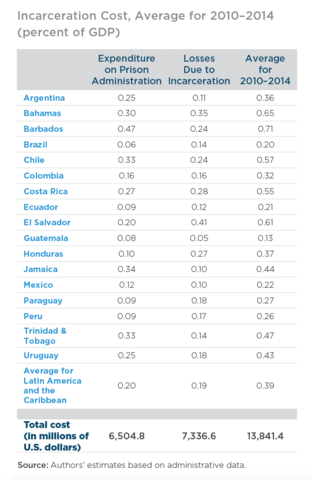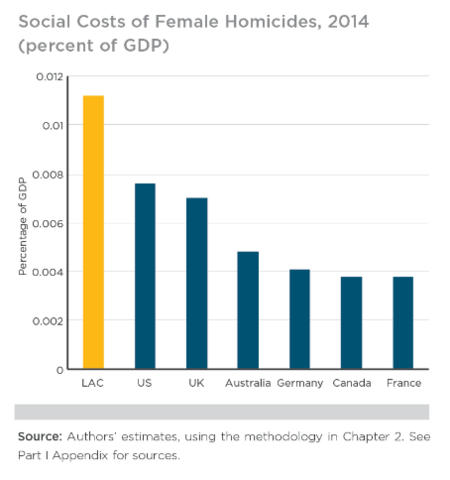- Annual costs of crime and violence estimated at $261 billion for region; impacts vary among and within countries
- Violence and crime impacts much higher than for developed nations
- Report calculates foregone income of murder victims, imprisoned individuals
A study by the Inter-American Development Bank (IDB) estimates the direct annual cost of crime and violence in Latin America and the Caribbean at $261 billion or 3.55 percent of GDP – roughly what the region invests on infrastructure and double the average cost for developed countries.

It is also the equivalent income for 30 percent of the poorest population, underscoring the grave development impact violence has on the region. The Costs of Crime and Violence: New Evidence, New Revelations in Latin America and the Caribbean is a landmark effort to provide comparable crime costs numbers for 17 countries in the region, benchmarking them against 6 developed countries.
Crime and violence are at near crisis levels in Latin America and the Caribbean. The region accounts for 9 percent of the world’s population but contributes nearly one-third of its homicide victims, making it the most violent region outside of war zones. Six out of ten robberies in the region involve violence and 90 percent of murders go unresolved. Its prisons are the most overcrowded in the world.

“Crime has reached alarming levels in many countries,” said Ana María Rodríguez, the manager of the IDB’s Institutions for Development Department. “By providing estimates of the costs of violence at the regional, sub-regional, and national levels, the study will help governments and international cooperation agencies better allocate resources, as well as design better policies to control and prevent crime.”

Crime-related costs are on average 3.55 percent of GDP in Latin America, compared with 2.75 percent in the US, 2.55 percent in the UK and 1.34 percent in Germany. If the region brings its crime costs down to the level of developed nations, it could increase its infrastructure investment by 50 percent.
The study breaks down the costs of crime into three parts.
- The social costs include lethal and non-lethal victimization and foregone income of prison populations: 0.64 percent of GDP
- Private spending on security by business and households: 1.37 percent of GDP
- Public spending, including the costs to the justice system, spending on police services and spending on prisons: 1.51 percent of GDP
The estimates are conservative as they include mainly direct costs of crime: public and private spending on security and the social costs. They do not include indirect costs such as changes in behavior due to fear of crime, or the impacts of crime on the health of persons.
As a percentage of GDP, public spending on crime-related areas in Latin America and the Caribbean is similar to the level in developed economies such as the U.S. and the United Kingdom. However, spending is a much bigger portion of public budgets, and private spending on crime prevention is vastly superior to that in more developed nations, the study shows.
The study provides a greater level of detail on how uneven the crime phenomenon is in the region – and within countries. High-crime states in Brazil such as Alagoas y Ceará have costs and rates that mirror more those of Northern Triangle countries (Guatemala, El Salvador and Honduras). Safer areas such as Bello Horizonte and Sao Paolo have numbers closer to Chile and Uruguay.

The study has chapters that analyze crime costs in Brazil, the Northern Triangle and the Caribbean and breaks new ground in calculating the direct costs of homicides as well as the foregone income of the victims of homicides (0.36 percent of GDP, or an annual average of $10.5 billion for the 2014-2015 period).

It also points out the steep costs of Latin America’s high incarceration rates. For the 2010-2014 period, the region spent $6.5 billion per year to maintain and build prisons. On top of this, imprisoned individuals forgo an additional $7.3 billion annually in income. The two numbers together amount to 0.39 percent of GDP, more than the conditional cash transfers for the region’s poor.
The study also notes that countries that spend more on prisons do not necessarily reap the benefits of less violence. The Bahamas and El Salvador, for instance, spend large sums (in terms of GDP) on their penitentiary systems but suffer from high crime rates. Argentina and Uruguay, on the other hand, have much lower incarceration costs and lower crime rates.
Costs of violence against women in Latin America and the Caribbean double the world average, and the study points to future avenues for more research on gender violence. The book includes chapters on cybercrime and organized crime.

About the IDB
The Inter-American Development Bank is a leading source of long-term financing for economic, social and institutional projects in Latin America and the Caribbean. Besides loans, grants and guarantees, the IDB conducts cutting-edge research to offer innovative and sustainable solutions to our region’s most pressing challenges. Founded in 1959 to help accelerate progress in its developing member countries, the IDB continues to work every day to improve lives.
Laura Jaitman

The Costs of Crime and Violence: New Evidence, New Revelations in Latin America and the Caribbean
Blog Sin Miedos
Citizen security and justice